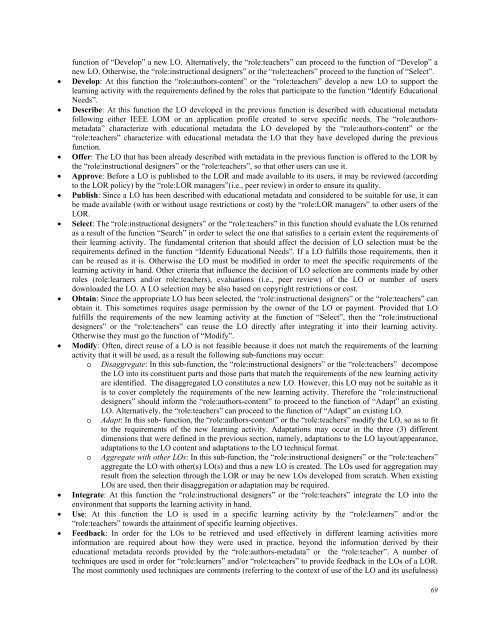October 2011 Volume 14 Number 4 - Educational Technology ...
October 2011 Volume 14 Number 4 - Educational Technology ...
October 2011 Volume 14 Number 4 - Educational Technology ...
Create successful ePaper yourself
Turn your PDF publications into a flip-book with our unique Google optimized e-Paper software.
function of “Develop” a new LO. Alternatively, the “role:teachers” can proceed to the function of “Develop” a<br />
new LO. Otherwise, the “role:instructional designers” or the “role:teachers” proceed to the function of “Select”.<br />
Develop: At this function the “role:authors-content” or the “role:teachers” develop a new LO to support the<br />
learning activity with the requirements defined by the roles that participate to the function “Identify <strong>Educational</strong><br />
Needs”.<br />
Describe: At this function the LO developed in the previous function is described with educational metadata<br />
following either IEEE LOM or an application profile created to serve specific needs. The “role:authorsmetadata”<br />
characterize with educational metadata the LO developed by the “role:authors-content” or the<br />
“role:teachers” characterize with educational metadata the LO that they have developed during the previous<br />
function.<br />
Offer: The LO that has been already described with metadata in the previous function is offered to the LOR by<br />
the “role:instructional designers” or the “role:teachers”, so that other users can use it.<br />
Approve: Before a LO is published to the LOR and made available to its users, it may be reviewed (according<br />
to the LOR policy) by the “role:LOR managers”(i.e., peer review) in order to ensure its quality.<br />
Publish: Since a LO has been described with educational metadata and considered to be suitable for use, it can<br />
be made available (with or without usage restrictions or cost) by the “role:LOR managers” to other users of the<br />
LOR.<br />
Select: The “role:instructional designers” or the “role:teachers” in this function should evaluate the LOs returned<br />
as a result of the function “Search” in order to select the one that satisfies to a certain extent the requirements of<br />
their learning activity. The fundamental criterion that should affect the decision of LO selection must be the<br />
requirements defined in the function “Identify <strong>Educational</strong> Needs”. If a LO fulfills those requirements, then it<br />
can be reused as it is. Otherwise the LO must be modified in order to meet the specific requirements of the<br />
learning activity in hand. Other criteria that influence the decision of LO selection are comments made by other<br />
roles (role:learners and/or role:teachers), evaluations (i.e., peer review) of the LO or number of users<br />
downloaded the LO. A LO selection may be also based on copyright restrictions or cost.<br />
Obtain: Since the appropriate LO has been selected, the “role:instructional designers” or the “role:teachers” can<br />
obtain it. This sometimes requires usage permission by the owner of the LO or payment. Provided that LO<br />
fulfills the requirements of the new learning activity at the function of “Select”, then the “role:instructional<br />
designers” or the “role:teachers” can reuse the LO directly after integrating it into their learning activity.<br />
Otherwise they must go the function of “Modify”.<br />
Modify: Often, direct reuse of a LO is not feasible because it does not match the requirements of the learning<br />
activity that it will be used, as a result the following sub-functions may occur:<br />
o Disaggregate: In this sub-function, the “role:instructional designers” or the “role:teachers” decompose<br />
the LO into its constituent parts and those parts that match the requirements of the new learning activity<br />
are identified. The disaggregated LO constitutes a new LO. However, this LO may not be suitable as it<br />
is to cover completely the requirements of the new learning activity. Therefore the “role:instructional<br />
designers” should inform the “role:authors-content” to proceed to the function of “Adapt” an existing<br />
LO. Alternatively, the “role:teachers” can proceed to the function of “Adapt” an existing LO.<br />
o Adapt: In this sub- function, the “role:authors-content” or the “role:teachers” modify the LO, so as to fit<br />
to the requirements of the new learning activity. Adaptations may occur in the three (3) different<br />
dimensions that were defined in the previous section, namely, adaptations to the LO layout/appearance,<br />
adaptations to the LO content and adaptations to the LO technical format.<br />
o Aggregate with other LOs: In this sub-function, the “role:instructional designers” or the “role:teachers”<br />
aggregate the LO with other(s) LO(s) and thus a new LO is created. The LOs used for aggregation may<br />
result from the selection through the LOR or may be new LOs developed from scratch. When existing<br />
LOs are used, then their disaggregation or adaptation may be required.<br />
Integrate: At this function the “role:instructional designers” or the “role:teachers” integrate the LO into the<br />
environment that supports the learning activity in hand.<br />
Use: At this function the LO is used in a specific learning activity by the “role:learners” and/or the<br />
“role:teachers” towards the attainment of specific learning objectives.<br />
Feedback: In order for the LOs to be retrieved and used effectively in different learning activities more<br />
information are required about how they were used in practice, beyond the information derived by their<br />
educational metadata records provided by the “role:authors-metadata” or the “role:teacher”. A number of<br />
techniques are used in order for “role:learners” and/or “role:teachers” to provide feedback in the LOs of a LOR.<br />
The most commonly used techniques are comments (referring to the context of use of the LO and its usefulness)<br />
69

















